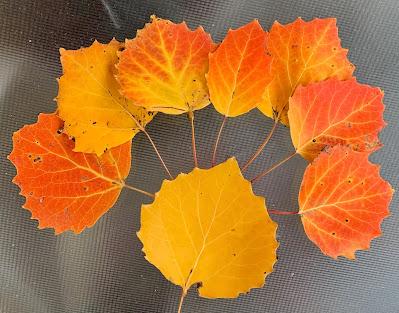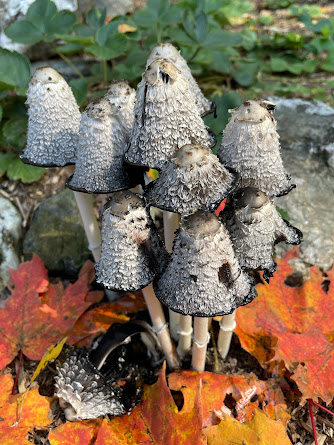October 29.
P. M. – To Eb. Hubbard’s old black birch bill.
Henry Shattuck’s is a new pitch pine wood, say thirty years old.
The western, or greater, part contains not a single seed-bearing white pine.
It is a remarkable proof of my theory, for it contains thousands of little white pines but scarcely one little pitch pine. It is also well stocked with minute oak seedlings.
It is a dense wood, say a dozen rods wide by three or four times as long, running east and west, with an oak wood on the north, from which the squirrels brought the acorns.
A strip of nearly the same width of the pitch pine was cut apparently within a year on the south (a part of the above), and has just been harrowed and sown with rye, and still it is all dotted over with the little oak seedlings between the stumps, which are perhaps unnoticed by Shattuck, but if he would keep his plow and fire out he would still have a pretty green patch there by next fall.
A thousand little red flags (changed oak leaves) already wave over the green rye amid the stumps.
The farmer stumbles over these in his walk, and sweats while he endeavors to clear the land of them, and yet wonders how oaks ever succeed to pines, as if he did not consider what these are.
Where these pines are dense they are slender and tall.
On the edge or in open land they are more stout and spreading.
Again, as day before yesterday, sitting on the edge of a pine wood, I see a jay fly to a white oak half a dozen rods off in the pasture, and, gathering an acorn from the ground, hammer away at it under its foot on a limb of the oak, with an awkward and rapid seesaw or teetering motion, it has to lift its head so high to acquire the requisite momentum. The jays scold about almost every white oak tree, since we hinder their coming to it.
At some of the white oaks visited on the 11th, where the acorns were so thick on the ground and trees, I now find them perhaps nearly half picked up, yet perhaps little more than two thirds spoiled.
The good appear to be all sprouted now.
There are certainly many more sound ones here than at Beck Stow’s and Hubbard’s Grove, and it looks as if the injury had been done by frost, but perhaps some of it was done by the very heavy rains of September alone.
Yesterday and to-day I have walked rapidly through extensive chestnut woods without seeing what I thought was a seedling chestnut, yet I can soon find them in our Concord pines a quarter or half a mile from the chestnut woods.
Several have expressed their surprise to me that they cannot find a seedling chestnut to transplant. I think that it is with them precisely as with the oaks; not only a seedling is more difficult to distinguish in a chestnut wood, but it is really far more rare there than in the adjacent pine, mixed, and oak woods.
After considerable experience in searching for these and seedling oaks, I have learned to neglect the chestnut and oak woods and go only to the neighboring woods of a different species for them. Only that course will pay.
On the side of E. Hubbard’s hill I see an old chestnut stump some two feet in diameter and nearly two feet high, and its outside and form well kept, yet all the inside gone; and from this shot up four sprouts in a square around it, which were cut down seven or eight years ago.
Their rings number forty-six, and they are quite sound, so that the old stump was cut some fifty-three years ago. This is the oldest stump of whose age I am certain.
Hence I have no doubt that there are many stumps left in this town which were cut in the last century.
I am surprised to find on this hill (cut some seven or eight years ago) many remarkably old stumps wonderfully preserved, especially on the north side the hill, — walnuts, white oak and other oaks, and black birch.
One white oak is eighteen and a half inches in diameter and has one hundred and forty-three rings. This is very one-sided in its growth, the centre being just four inches from the north side, or thirty - six rings to an inch. Of course I counted the other side.
Another, close by, gave one hundred and forty-one rings, another white oak fifteen and a half inches in diameter had one hundred and fifty-five rings. It has so smooth (sawed off) and solid, almost a polished or marble- ike, surface that I could not at first tell what kind of wood it was.
Another white oak the same as last in rings, i. e. one hundred and fifty-five, twenty-four inches in diameter. All these were sound to the very core, so that I could see the first circles, and I suspect that they were seedlings.
The smaller, but oldest ones had grown very slowly at first, and yet more slowly at last, but after some sixty five years they had then grown much faster for about fifteen years, and then grew slower and slower to the last. The rings were exceedingly close together near the outside, yet not proportionably difficult to count.
For aught that appeared, they might have continued to grow a century longer.
The stumps are far apart, so that this formed an open grove, and that probably made the wood sounder and more durable.
On the south slope many white pines had been cut about forty-six years ago, or when the chestnut was, amid the oaks. I suppose that these were seedlings, and perhaps the hill was cleared soon after the settlement of the town, and after a while pines sprang up in the open land, and seedling oaks under the pines, and, the latter being cut near the end of the seventeenth century, those oaks sprang up, with or without pines, but all but these were cut down when they were about sixty years old.
If these are seedlings, then seedlings make much the best timber.
I should say that the pasture oaks generally must be seedlings on account of their age, being part of the primitive wood.
I suspect that sprouts, like the chestnut, for example, may grow very rapidly, and make large trees in comparatively few years, but they will be decaying [?] as fast at the core as they are growing at the circumference. The stumps of chestnuts, especially sprouts are very shaky.
The oldest of these oaks began their existence about 1697. I doubt if there were any as old trees in our primitive wood as stood in this town fifty years ago.
The healthiest of the primitive wood, having at length more room, light, and air, probably grew larger than its ancestors.
Some of the black birch stumps gave about one hundred rings.
The pasture oak which Sted Buttrick cut some seven or eight years ago, northeast of this, was, as near as I could tell, — one third was calculation, — some one hundred years old only, though larger than any of these.
The fine chips which are left on the centre of a large stump preserve it moist there, and rapidly hasten its decay.
The site of the last - named pasture oak was easily discovered, by a very large open grass - sward where no sweet - fern, lambkill, huckleberry, and brakes grew, as they did almost everywhere else.
This may be because of the cattle assembling under the oak, and so killing the bushes and at the same time manuring the ground for grass.
There is more chestnut in the northern part of the town than I was aware of.
The first large wood north of Ponkawtasset is oak and chestnut. East of my house.













